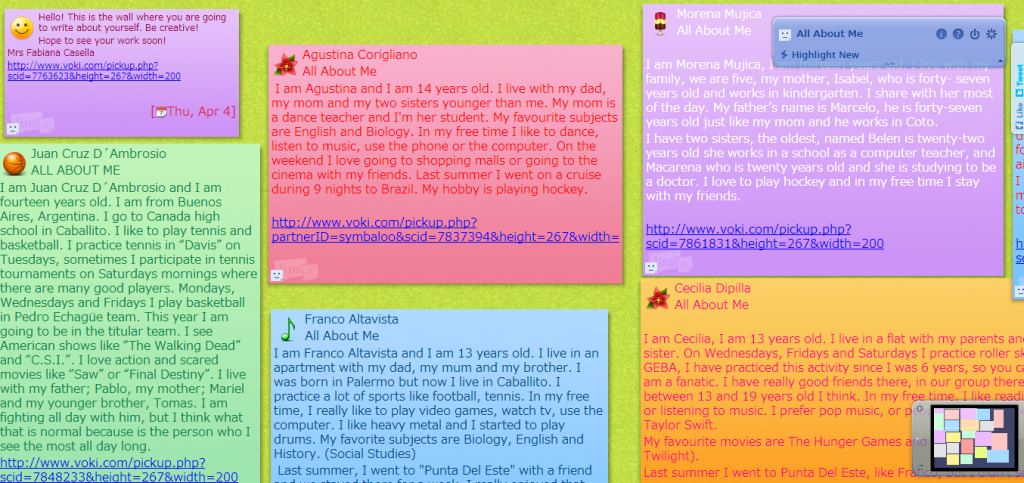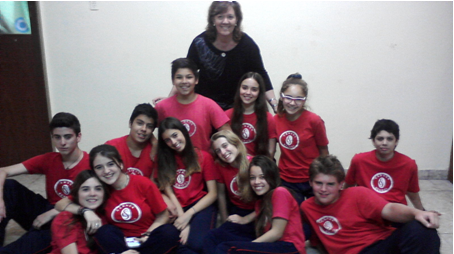Everybody is talking about 21st Century skills and
preparing students for a whole different world. The truth is that our
students have become digital and there are a whole lot of educators
around the world who are still “analog”. That is why I would like to
share my work with my two secondary school groups with as many teachers
as possible. Internet and Technology in the Classroom have made a huge
change in my daily teaching experience.
My story starts right after my first online presentation for The
Future of Education Reform Symposium 2013, (RSCON4) where I was kindly
invited to participate by Shelly Sanchez Terrell. Some hours later, I
got a message from Barbara Hoskins Sakamoto, who asked me if I would
like to write for this High Tech Ideas in the Low Tech Classroom section
in Teaching Village. I was flattered, and accepted immediately, but it
really took me quite a long time to put ideas together and I thank my
dear friend, Rose Bard, for giving me some support.
We do not have computers or tablets in the classroom, only computer labs which are used for computing classes mainly. So when I wanted to integrate technology in my classes, I decided to ask my lovely students and parents as well as administrators, if they would agree with the use of cell phones or Smartphones during the English classes. The answer was an enthusiastic “YES!! Why not? Absolutely!” They were all very supportive.
We do not have computers or tablets in the classroom, only computer labs which are used for computing classes mainly. So when I wanted to integrate technology in my classes, I decided to ask my lovely students and parents as well as administrators, if they would agree with the use of cell phones or Smartphones during the English classes. The answer was an enthusiastic “YES!! Why not? Absolutely!” They were all very supportive.

My first step was to open an account in Edmodo, the educational
platform for teachers, in order to protect my students’ online identity.
In this way, I was able to have my students download the Edmodo
application, or simply go to the webpage, sign in and join the group I
had created for them. It was a fantastic experience for the children and
for me. Just seeing them setting their phones in English, then creating
a username and password to become members of the group, and finally
reading my welcome post filled my heart with pride and joy. There were
some students who obviously could not log in so easily, and that turned
into one of the best moments. Students started to help each other,
giving instructions in English and using the target language beyond the
classroom context! From here, we were able to use many online tools and
applications as part of our lessons.

Last year, the fact that 100% of my students had a Smartphone (except
for me as I just bought one) was a double advantage. I was able to
blend my classes, post follow up activities and also some articles to be
discussed in class. They could also show me their work in class or even
log in and ask me questions about my posts. It certainly required a
much bigger effort for me, because I had to think what to teach
face-to-face and to check my students’ online assignments and the ones
written on paper, the traditional way!
Anyway, I am proud to say that these children responded wonderfully!
Almost all of them worked hard all year and completed all of the
projects. Those who did not manage to complete all the work were unable
to do so because of problems with their Internet connection or power
outages at home, the two principal and very common obstacles around this
area.
No matter how much you trust your
students, as a teacher you need to keep a close watch, and rethink or
polish your classroom management skills to suit new situations. My
students are teenagers and can start chatting on Whattsap in less than a
second! When I caught one of my students on Twitter (without my
permission), I asked him to “tweet” in English. That turned into an
incredible experience, because his “friends” replied in English, too,
while we were in class. Later, students spontaneously volunteered to
retell the updated news in every class. It was completely their idea! So
we had Twitter readers from The New York Times, Reuters, CNN and other
news broadcasters. Having a speaker every class was a real delight! These reports led to discussions on current topics, all in English.

Since we began using cell phones in class, my students and I have
worked on many exciting and educational projects together, and with
other teachers and students around the world. You can learn more about
our projects in this recording from my RSCON presentation (the the slides are on slideshare) or an interview I did with Vicky Loras.

How did I learn how to integrate cell phones in my teaching? I am not
a an expert techy teacher! I am just a teacher! (I know Cecilia Lemos
would not like to hear me say that!) Honestly, I am just a teacher who
believes in motivation, creativity and happiness in the classroom.
Integrating some technology, as I stated above, made a big difference in
my classes. First of all, I promised my students we were going to go
GREEN and we did! Later, I said they were going to be able to express
themselves in different learning contexts and they did! I think that
practicing their foreign language both in the classroom and beyond the
limits of the school has been key to student progress. How did I learn
to integrate tech tools? I started to read articles, browse Internet
websites on technology in education, and listen to the experts by
attending as many free online webinars as I could, because conferences
and lectures here are too pricey.
During 2012, I had the chance to take a course taught by marvelous
Jennifer Verschoor on Tech Tools for the English class, certified by the
National Technological University of Argentina. That was the starting
point. Since then, I have read and listened to Shelly Sanchez Terrell,
Nicky Hockly, Gavin Dudeney, Nik Peachy, Pete Sharma, Vicki Hollet, Rita
Zeinstejer (Argentina) and many more. In March 2013, I decided to start
studying a Specialization in Education and ICT delivered by the
Ministry of Education, so now I have a much more “formal” tuition. “If
there is a will, there is a way” is one of my favorite English proverbs,
and I believe that this is especially true in teaching. Even if you
have a low tech classroom, you can find a way to integrate technology
into your teaching!
 Fabiana Laura Casella is a passionate English teacher from Argentina, blessed mother of two,
and very interested in ELT, Education, Literature, History, Psychology,
Music and being a Connected Educator. She has been teaching English to all levels of children, teenagers and adults since she got her Bachelors Degree in Teaching English as a Foreign Language. Between 2001 and 2008, she moved to the United States with her family, where she taught Middle and High School ESL and High School Spanish. Fabiana believes that getting
involved in social media and staying in touch with educators around the
world has made her grow as a teacher tremendously. You can follow
Fabiana on Twitter (@FLCasella) and learn more about her class projects on her blog.
Fabiana Laura Casella is a passionate English teacher from Argentina, blessed mother of two,
and very interested in ELT, Education, Literature, History, Psychology,
Music and being a Connected Educator. She has been teaching English to all levels of children, teenagers and adults since she got her Bachelors Degree in Teaching English as a Foreign Language. Between 2001 and 2008, she moved to the United States with her family, where she taught Middle and High School ESL and High School Spanish. Fabiana believes that getting
involved in social media and staying in touch with educators around the
world has made her grow as a teacher tremendously. You can follow
Fabiana on Twitter (@FLCasella) and learn more about her class projects on her blog.
Tags:
Current Issues


Well, I kind of don't agree with this kind of teaching methodology because in this case, the chances are greater for students to get distracted and start chatting with friends on their phones or play games
ReplyDelete